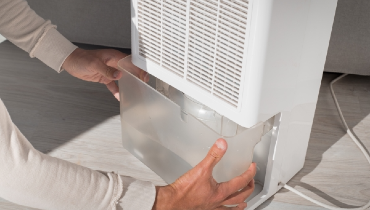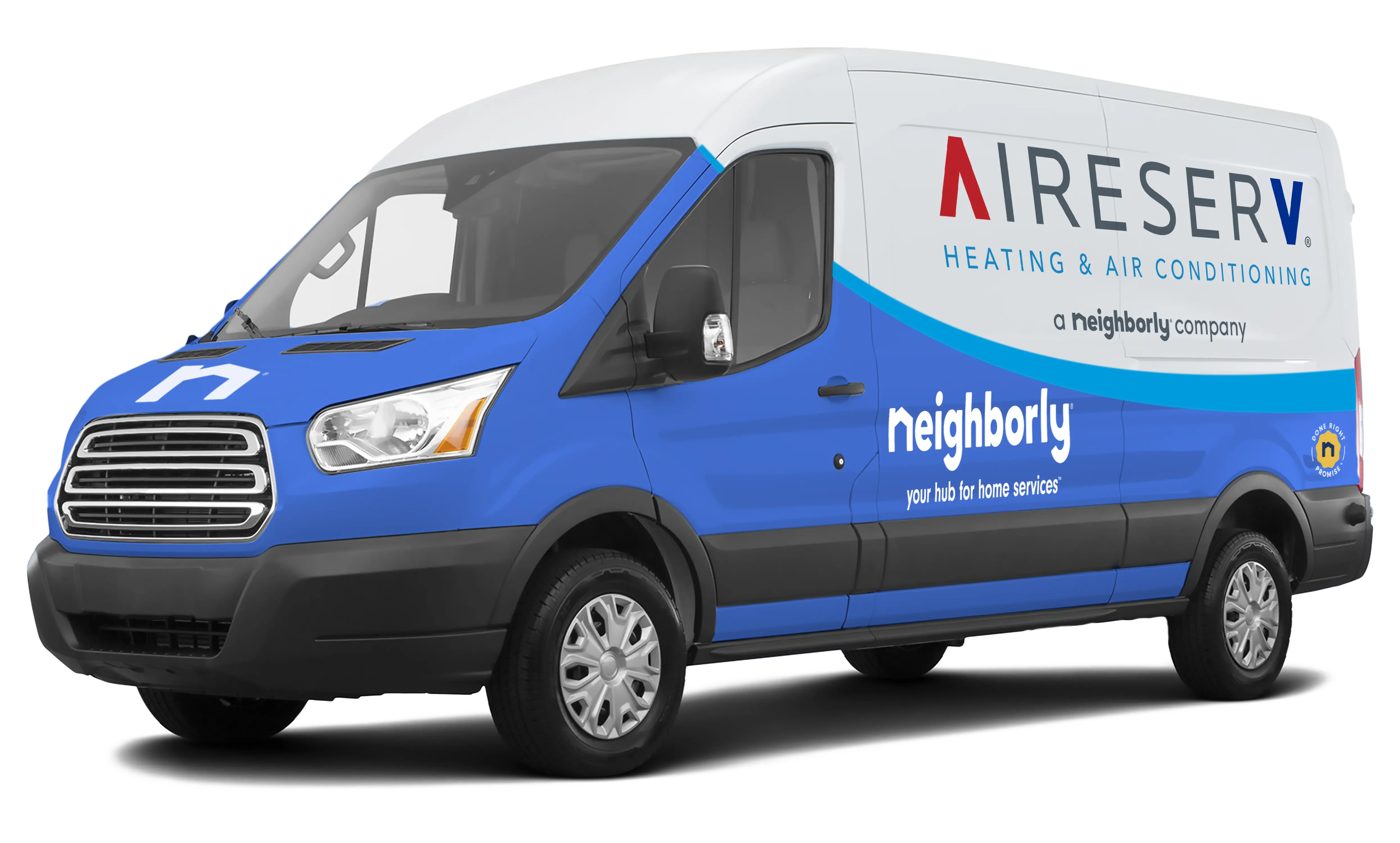
Aire Serv experts explain how often dehumidifiers need to be emptied for optimal performance.
- Check the water tank daily, especially in humid conditions.
- Empty the tank when full to prevent overflow.
- Clean and inspect the tank regularly to avoid mold.
- Consider using a hose for continuous drainage if available.
While many homeowners empty their dehumidifiers once a day, factors like the unit size and home humidity levels can require more or less frequency.
If your dehumidifier fills up quickly, the cause may be excess humidity in your home or an issue with the dehumidifier itself. However, a consistently empty dehumidifier is also often a sign of system malfunction. If either of these issues persists, professional dehumidifier repair or maintenance services can help restore proper function.
This article reviews the signs of a full dehumidifier and common issues homeowners encounter during everyday dehumidifier use.
Your Humidifier’s Daily Water Intake
If you have a humid home and your dehumidifier settings are correct, your humidifier will collect water. But you might be surprised at just how much water your unit is pulling out of the air. The volume will vary depending on the humidity level and the capacity of the collection tank, but an average home dehumidifier may collect from 1 to 5 gallons of water per day!
With this volume, it’s easy to see how quickly your unit can reach capacity—and how essential it is to empty it regularly. Review your manufacturer information to determine your unit’s capacity, then monitor its collection volume for a few days to get an idea of how full it becomes with regular use.
Related Topic: How to Use a Dehumidifier
Finding Your Optimal Humidity
Most homeowners are comfortable with an optimal humidity level between 30–50%, which your dehumidifier should be able to reach in 8 to 12 hours. However, if the unit has a greater capacity than the space requires, you may find it achieves your desired humidity in only a few hours. On the other hand, if the dehumidifier’s capacity is less than the space needs, it may run constantly to try to keep up.
Your dehumidifier should not have to run constantly to regulate the air humidity. If you find that your unit never shuts off or needs to be emptied more than once a day, consider upgrading to a higher-capacity model.
Related Topic: What Is the Best Humidity Setting for a Dehumidifier?
Additional Ways to Control Humidity in Your Home
If your dehumidifier can’t keep up with your home’s needs, take the following steps:
Reduce incoming humidity
- Avoid hang-drying laundry indoors. The moisture from the clothes will evaporate into the air, increasing humidity levels.
- Fix pipe leaks. Pipes don’t leak into the air, but warm air will evaporate the water from a leak, increasing air humidity.
- Reduce hot showers. While hot showers are relaxing, steam fills the air with excess moisture. Even if you can’t bring yourself to take cold showers, reducing the water heat and shower length can make a significant difference.
Remove existing humidity
- Install fans. Your kitchen, bathroom, attic, and basement are all prime areas for humidity to collect and linger. Installing exhaust fans or ceiling fans in these areas can help improve air circulation and ventilation in your home.
- Upgrade to a whole-house dehumidifier. Portable dehumidifiers are often only effective for a single room or temporary use. Upgrading to a whole-house dehumidifier can provide a more effective, quieter solution that also requires less maintenance.
- Maintain your HVAC system. If your HVAC system isn’t operating efficiently due to a lack of maintenance, it cannot maintain proper airflow and temperature in your home. Have an HVAC service professional inspect and clean your system and change air filters regularly. Expert HVAC maintenance allows for better control of excess home humidity.
Professional Whole-House Dehumidifier Services
Your dehumidifier works hard to keep your home’s humidity under control. Emptying it regularly and ensuring it receives proper maintenance can mean a world of difference for your home’s comfort. If you notice that your dehumidifier fills up quickly, runs constantly, or is not collecting any water, contact your local Aire Serv® experts for professional dehumidifier services. We have the experience and training to identify and correct the problem quickly, with all services backed by the Neighborly Done Right Promise® to ensure your satisfaction. To get started, request an appointment online today!
This article is intended for general informational purposes only and may not be applicable to every situation. You are responsible for determining the proper course of action for your home and property. Aire Serv is not responsible for any damages that occur as a result of this blog content or your actions. For the most accurate guidance, contact the Aire Serv location nearest you for a comprehensive, on-site assessment.
FAQs About Dehumidifier Maintenance
As an industry leader and a brand that is trusted by homeowners and businesses nationwide for our knowledge and experience, we’re happy to answer your HVAC questions. Here are answers to some of the frequently asked questions about dehumidifiers.
How can I tell when my dehumidifier needs to be emptied?
Most modern dehumidifiers are quite intuitive and will give you clear indicators of when it’s time to empty the water.
- Automatic shut-off: The most common sign is the dehumidifier simply turning off. This usually means the water tank is full, and a safety mechanism has kicked in to prevent overflow.
- Full tank indicator light: Many units have a light that illuminates when the tank is full or nearing capacity.
- Audible cues: Some dehumidifiers make a slightly different or strained sound when the tank is full, although this is not always a reliable indicator.
- Visual inspection: Periodically take a peek at the water level in the collection tank if it's visible. Don't wait for it to become completely full before you empty it.
How long should a dehumidifier run per day?
The duration a dehumidifier should run every day depends on the current humidity level in the space, your desired humidity level, the size of the space, the dehumidifier's capacity, ventilation, and other factors.
Here are some general guidelines for how long a dehumidifier should run:
- Initial drying: When using a dehumidifier in a damp space for the first time, run it continuously for 24 to 48 hours on a low humidity setting (around 30%) to thoroughly dry the area.
- Regular use: To maintain a comfortable humidity level (30–50%), running the dehumidifier for 8 to 12 hours per day is often sufficient. You use shorter intervals or run it continuously if needed.
- Maintenance: Once the humidity is at a comfortable level, you may only need to run the dehumidifier for a few hours a day or every few days to maintain the desired range.
- High humidity or specific issues: In very humid conditions or when drying laundry, you may need to run the unit for 12 to 16 hours or even continuously until the problem is resolved.
Do dehumidifiers turn off when full?
Most dehumidifiers have an auto-off switch that deactivates the unit either when the collection tank is full or when your space reaches the set humidity level. If your dehumidifier is overflowing, there may be an issue with your humidity settings or the auto-off function.
How much water should a dehumidifier collect in a day?
Dehumidifiers collect varying amounts of water every day, depending on the current humidity level, the desired humidity level, the size and capacity of the dehumidifier, and the size of the space.
Here are some typical rates based on the size of your unit:
- Small (one-room) dehumidifier: 10–20 pints/day (1.5–3 gallons)
- Medium-capacity dehumidifier: 30–50 pints/day (4.5–7.5 gallons)
- Large-capacity dehumidifier: 70+ pints/day (up to 10.5 gallons or more) in extremely humid conditions
Initial Use: When you first start using a dehumidifier in a very humid space, it may collect a significant amount of water daily as it works to reduce the humidity.
Maintenance Mode: Once you reach your desired humidity level (usually between 30% and 50%), the dehumidifier will collect less water, as it only needs to remove the moisture entering the space.
If your dehumidifier is collecting too much or not enough water daily, contact Aire Serv for whole-house dehumidifier services or commercial dehumidifier repair and replacement. We can help you diagnose the problem and get it fixed quickly.
Should a dehumidifier run constantly?
Whether a dehumidifier should run constantly depends on the humidity levels and your needs. Initially, in a very damp space, continuous operation for 24 to 48 hours may be necessary to lower the humidity significantly. However, once the desired humidity (30% to 50%) is reached, running the dehumidifier constantly isn't usually efficient or necessary.
Using a dehumidifier with a built-in humidistat is ideal. You set your target humidity, and the unit cycles on and off to maintain it, preventing over-drying and saving energy. Continuous running after reaching the target can dry the air excessively, potentially causing discomfort and increased energy consumption. Monitor humidity levels with a hygrometer to determine the optimal run time for your situation.
Once you learn the science behind a dehumidifier, you can better use the machine along with a humidistat and hygrometer to make your home more comfortable.
How quickly should a dehumidifier fill up?
In very humid conditions, especially upon initial startup, a dehumidifier might fill its tank within 6 to 8 hours, or even faster if the humidity is exceptionally high and the tank capacity is small. However, if the humidity level is already close to your target, the dehumidifier will fill much more slowly. Once the desired humidity is reached, the unit will cycle on and off, collecting only the moisture that enters the space.
If your dehumidifier is filling up fast, it may indicate very high humidity due to leaks or poor ventilation. Conversely, a dehumidifier that never fills might have incorrect settings, a dirty filter, frozen coils (in cool temperatures), or mechanical issues. Monitoring the fill rate in relation to the humidity levels can help you understand if the unit is working efficiently.
Aire Serv’s Ultimate Dehumidifier Maintenance Checklist can help you understand how to keep your dehumidifier up and running. If your unit stops working properly, contact our service professionals to get it fixed quickly.
Why does my dehumidifier bucket still fill when a hose is attached?
When a dehumidifier bucket fills with a hose attached, it indicates a problem with the drainage. The most common culprit is an issue with the hose itself. Ensure the hose isn't clogged, kinked, or bent and that the hose is routed downward consistently from the dehumidifier's drain port to the drain.
Another possibility is an improper connection at either the dehumidifier or the drain end. Make sure the hose is securely attached with a tight seal. Some dehumidifiers might have a drain plug that needs to be removed for hose drainage to function. Finally, if the hose end is submerged in standing water, back pressure can prevent proper drainage.
In some cases, internal issues within the dehumidifier might cause the issue, but the external hose setup is the most common cause. If you still have problems after carefully inspecting the hose and connections, contact your local Aire Serv team.
If I don’t empty my dehumidifier, will mold grow?
Yes, if you don't empty your dehumidifier regularly, mold growth is a significant risk. The collected water in the dehumidifier's bucket provides a stagnant, damp environment—a perfect breeding ground for mold spores.
Dust and other organic matter that get drawn into the dehumidifier can settle in the water, providing nutrients for mold to feed on. Additionally, the inside of the dehumidifier bucket is often dark and remains consistently humid due to the collected water, further promoting mold growth.
Once mold starts to grow in the dehumidifier, it can release spores into the air when the unit is running, potentially spreading mold throughout your home. Mold spores can lead to health problems, especially for individuals with allergies or respiratory issues.
Empty your dehumidifier frequently, ideally daily or at least every few days, to prevent mold growth. Regularly clean the bucket with a mild bleach solution or vinegar to help inhibit mold.
Learn more about how to prevent mold in dehumidifiers.

